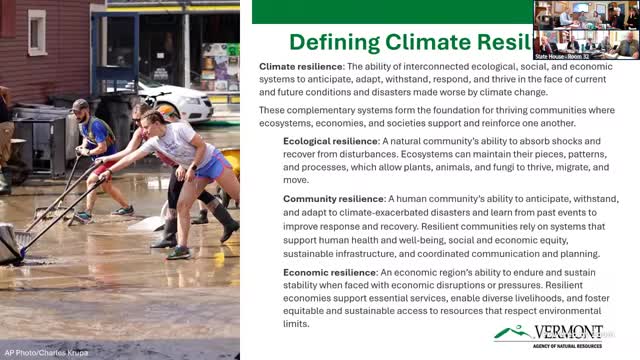Vermont develops climate resilience strategy with state agencies and climatologists
March 29, 2025 | Environment & Energy, HOUSE OF REPRESENTATIVES, Committees, Legislative , Vermont
This article was created by AI summarizing key points discussed. AI makes mistakes, so for full details and context, please refer to the video of the full meeting. Please report any errors so we can fix them. Report an error »

In a recent meeting held by the Vermont House Energy and Digital Infrastructure, officials discussed the development of a comprehensive climate resilience implementation strategy. This initiative aims to address the growing impacts of climate change on Vermont's communities, ecosystems, and economy. The meeting highlighted the collaborative efforts of a steering committee, which includes various state agencies and the Vermont State Climatologists, to define climate resilience and identify key priorities for action.
The definition of climate resilience presented during the meeting emphasizes not only the need to reduce long-term risks but also the importance of preparing for, withstanding, and recovering from climate-related disasters. This broad perspective recognizes the interconnectedness of ecological, community, and economic systems as foundational to Vermont's resilience.
Five core areas were identified as focal points for the resilience strategy. These include:
1. **Community-Centric Approach**: This area stresses the importance of equitable engagement in decision-making processes and the need to support vulnerable populations who are disproportionately affected by climate change.
2. **Nature-Based Solutions**: This approach looks at leveraging natural systems to mitigate climate impacts while promoting biodiversity and safeguarding ecosystems.
3. **Infrastructure**: The strategy includes plans for repairing and enhancing critical infrastructure, such as roads, bridges, and utilities, to ensure they can withstand climate challenges.
4. **Early Warning Systems**: Comprehensive emergency management systems are crucial for minimizing physical and economic damages during climate disasters.
5. **Economic and Environmental Sustainability**: This area aims to strengthen the economic resilience of communities and businesses while recognizing the interdependence of economic viability and climate resilience.
Additionally, the meeting introduced a sixth cross-cutting system that emphasizes the need for an all-of-government approach. This approach aims to integrate resilience priorities into all decision-making processes, ensuring that state actions are adaptable to the evolving challenges posed by climate change.
The resilience implementation strategy is expected to be completed by July and is structured in three phases, starting with an inventory of existing state government initiatives and resources. This foundational work will guide future actions and policies aimed at enhancing Vermont's resilience to climate impacts.
As Vermont continues to confront the realities of climate change, the discussions from this meeting underscore the state's commitment to proactive and inclusive strategies that prioritize the well-being of its communities and the environment. The anticipated completion of the resilience strategy will be a significant step toward addressing these pressing challenges.
The definition of climate resilience presented during the meeting emphasizes not only the need to reduce long-term risks but also the importance of preparing for, withstanding, and recovering from climate-related disasters. This broad perspective recognizes the interconnectedness of ecological, community, and economic systems as foundational to Vermont's resilience.
Five core areas were identified as focal points for the resilience strategy. These include:
1. **Community-Centric Approach**: This area stresses the importance of equitable engagement in decision-making processes and the need to support vulnerable populations who are disproportionately affected by climate change.
2. **Nature-Based Solutions**: This approach looks at leveraging natural systems to mitigate climate impacts while promoting biodiversity and safeguarding ecosystems.
3. **Infrastructure**: The strategy includes plans for repairing and enhancing critical infrastructure, such as roads, bridges, and utilities, to ensure they can withstand climate challenges.
4. **Early Warning Systems**: Comprehensive emergency management systems are crucial for minimizing physical and economic damages during climate disasters.
5. **Economic and Environmental Sustainability**: This area aims to strengthen the economic resilience of communities and businesses while recognizing the interdependence of economic viability and climate resilience.
Additionally, the meeting introduced a sixth cross-cutting system that emphasizes the need for an all-of-government approach. This approach aims to integrate resilience priorities into all decision-making processes, ensuring that state actions are adaptable to the evolving challenges posed by climate change.
The resilience implementation strategy is expected to be completed by July and is structured in three phases, starting with an inventory of existing state government initiatives and resources. This foundational work will guide future actions and policies aimed at enhancing Vermont's resilience to climate impacts.
As Vermont continues to confront the realities of climate change, the discussions from this meeting underscore the state's commitment to proactive and inclusive strategies that prioritize the well-being of its communities and the environment. The anticipated completion of the resilience strategy will be a significant step toward addressing these pressing challenges.
View full meeting
This article is based on a recent meeting—watch the full video and explore the complete transcript for deeper insights into the discussion.
View full meeting